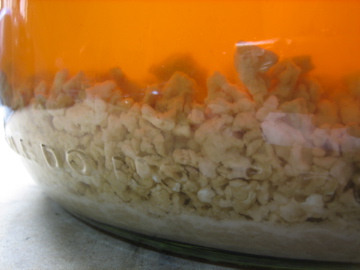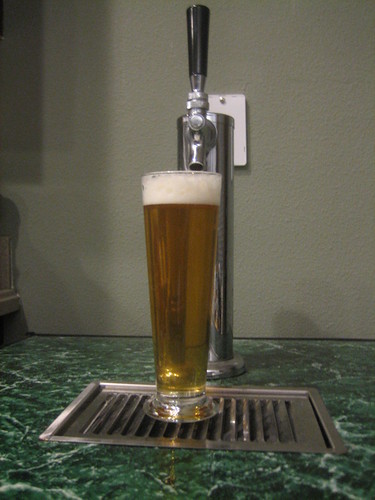danotts
Member
I brewed my first all grain batch this past weekend. It's been happily fermenting away for 3 days, and is almost done. It's a Koelsch using mostly Weyermann pilsner malt, a bit of wheat malt, and WLP-029 koelsch yeast from a starter (1.2 oz Perle boiling, and 1 oz. Spalt aroma). I used a single infusion mash at 147 F for one hour. The one thing that I think is "wierd" about this batch is that I used 2 tsp of Polyclar Brewbrite, a PVPP/carageenan mix in the last 15 min of the boil to help clarify the beer. I don't have much experience with this fining agent.
I've brewed a similar recipe before using a partial mash technique. After 2 years of homebrewing, I've never seen these type of curds before. I hope the image shows up. If it doesn't, the curds are grey-ish, about the size of coarse cottage cheese curds, and they were floating at the top of the carboy with the high krauesen up until today (the 3rd day of fermentation at 70 F). Now they are resting at the bottom of the carboy, above the white yeast layer.
I must say the green beer looks quite clear. through the carboy wall. Any feedback from the homebrewtalk community on what these curds might be? I noticed similar curds in the boiling wort. Is this just coagulated protein? Thanks in advance for your feedback.

I've brewed a similar recipe before using a partial mash technique. After 2 years of homebrewing, I've never seen these type of curds before. I hope the image shows up. If it doesn't, the curds are grey-ish, about the size of coarse cottage cheese curds, and they were floating at the top of the carboy with the high krauesen up until today (the 3rd day of fermentation at 70 F). Now they are resting at the bottom of the carboy, above the white yeast layer.
I must say the green beer looks quite clear. through the carboy wall. Any feedback from the homebrewtalk community on what these curds might be? I noticed similar curds in the boiling wort. Is this just coagulated protein? Thanks in advance for your feedback.





